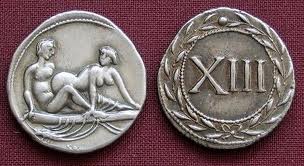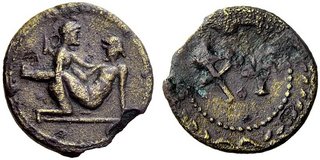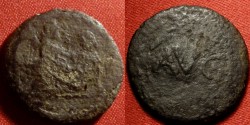Sex and Roman Coins August 7, 2010
Author: Beach Combing | in : Ancient , trackback
Beachcombing has waited for the family and some houseguests to vanish into the local countryside before addressing this particularly delicate theme. Spintria was a rare Latin word, used most vividly by Suetonius to describe the sexual acts of that old goat, the Emperor Tiberius on the island of Capri (43). But the word has also been employed, since at least the nineteenth-century, to describe a class of Roman coins that Beachcombing has coyly shown above: higher resolution copies follow below for the brave of heart.
The coins were brass or bronze and about two centimetres wide. On one side they had a Roman numeral (typically, but not always, I-XVI) and on the other side an act of sexual intercourse.
Beachcombing has spent an hour this afternoon pouring over these and thinks it fair to say that most possibilities were covered and that the detail on the coins left nothing to the imagination.
Numismatists have understandably got steamy under the collar about these ‘tokens’, one of the very few sexually-charged objects to come under their purview. At least up until recent times most went to great lengths to express just how disgusting they found they whole series.
So Joseph Eckhel (1737-1798) wanted them ‘thrown into the rear, like the settlers, soldiers’ boys, wine sellers, and strumpets of a great army, [they] are to be recorded more to avoid the slightest deficiency in anything that could throw light upon the subject of Roman coins than from the profit to be derived from them to learning and to a useful knowledge of antiquity.’
Beachcombing thinks that that the great Jesuit numismatist doth protest too much.
More interesting though than difficult modern encounters with antiquity are the question of what in God’s name these coins were for. They were not part of the normal moneyed economy and were issued (if that is the right word) for a relatively short time in the first century. And, though rare, enough survive to demonstrate that they were not the act of a rogue minter from a minor Roman provincial centre.
It has been suggested that they were tokens to be used at brothels – it is even argued that the sexual acts shown on the spintria could have been employed with prostitutes or customers who did not speak Latin!
Likewise it has been suggested that they were coins for seats at the games or the theatre or even tokens used at the bath. Then there is too the possibility that they were gaming pieces or insults against Tiberius. If Beachcombing had the time he could almost certainly come up with some more including corn dole, raffles, jokes etc etc.
Though the modern world fixates on the pictures it is probable that the numerals mattered far more to the ancients.
Beachcombing notes here an excellent online article that tries to get to the bottom of the question: ‘Is that a spintria in your pocket, or are you just pleased to see me?’ He would also love to hear of any other risque coins from antiquity. drbeachcombingATyahooDOTcom



